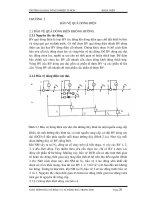2 chapter2 2 weldingmaterials
Bạn đang xem bản rút gọn của tài liệu. Xem và tải ngay bản đầy đủ của tài liệu tại đây (76.2 KB, 2 trang )
Welding Materials
Seite 1 von 2
A Beginner's Guide to the Steel Construction Manual
Chapter 2 - Materials
© 2006, 2008 T. Bartlett Quimby
Steel Materials
Section 2.2
Welding
Materials
Bolts
References
Report Errors
or Make
Suggestions
Purchase Hard
Copy
Make
Donation
Welding Materials
Last Revised: 08/07/2008
There is quite a lot to fully understanding welding materials, but in
keeping with the theme that simple is better for beginning engineers,
we will endeavor to stay focused on those pieces of information
necessary to get a jump start into designing welds. Discussion about
the types of welds and their capacities are left for our discussion on the
design of welds later on.
The welding process and its materials are governed by the American
Welding Society's (AWS) specification AWS D1.1: Structural Welding
Code - Steel. The AISC specification covers design procedures. The
design procedures are highly dependent on the process and material
requirements of AWS D1.1.
The Basic Welding Process
Welding is the process of uniting two metal parts by melting the
materials at their interface so that they will bond together. A filler
material is typically used to join the two parts together. The parts being
joined are referred to as base metal and the filler is referred to as
weld metal. Since structural welding is typically done by an electrical
arc process, the weld metal is typically supplied via weld electrodes,
sometimes known as welding rods.
We'll discuss this more later, but the quality of weld is highly dependent
on a number of factors, one of which is the nature of the base metals
and the weld metal used to join them.
The AWS has developed specifications for what metals can be connected
by what electrodes. This information is contained in AWS D1.1. For this
text, we will work with basic information. For now, use either a 60 ksi
or 70 ksi electrode for steels with Fu in the neighborhood of 60 ksi
(ASTM A36 steel) and 70 ksi electrodes for steels with Fu between 65 ksi
and 75 ksi. The AWS specification also has provisions for developing
weld procedures for other materials and configurations. In practice, you
should consult the AWS specification for selecting the electrodes to be
used with your selected materials.
/>
27.12.2009
Welding Materials
Seite 2 von 2
Weld Electrodes
As will be discussed later, we will focus on two primary forms of
structural welding: The Shielded Metal Arc Welding (SMAW) and
Submerged Arc Welding (SAW) processes. The electrodes used for
these two process are very different in their makeup.
The one thing that
you need to know at
this point is that
part of the
designation of an
electrode is its
specified minimum
tensile strength, Fu.
Figure 2.2.1
SMAW Process Electrodes
The main criteria we
will use for selecting
weld metals is to
find one that
somewhat matches
the Fu of the base
metals.
For the SMAW
process, the electrode designation takes the form: E__XX, where the
blank contains the Fu of the base metal and the XX is a number of more
importance to the welder than the engineer. For example, and E60XX
electrode has an Fu of 60 ksi. SMAW process electrodes are available in
Fu values of 60, 70, 80, and 100 ksi. Figure 2.2.1 shows the electrode
ends that attach to the welding machine for some E70XX electrodes.
For the SAW process only the first number of Fu is used. SAW process
electrodes go by the designator F_XX. The common versions include
F6XX, F7XX, F8XX, F10XX, F11XX which have Fu values of 60, 70, 80,
100, and 110 ksi respectively.
We will go into electrode selection and use more in the chapter on weld
design.
<<< Previous Section <<<
>>> Next Section >>>
/>
27.12.2009









